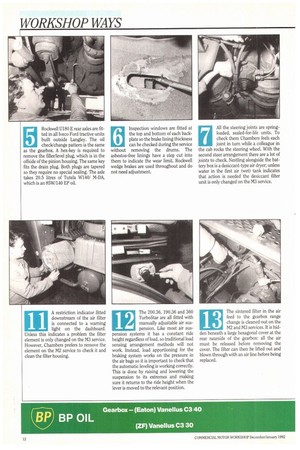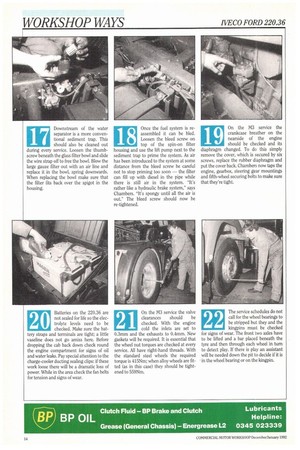Chambers drives the vehicle over the pit and starts the
Page 79

Page 80

Page 81

Page 82

If you've noticed an error in this article please click here to report it so we can fix it.
service with the usual in-cab checks. The test button on the dash illuminates the warning lights to confirm none are blown. Head and brake lights, indicators, wipers, washers, electric windows and mirrors, ventilation and gauges are all checked. There is a warning light for the low air pressure alarm but no buzzer. Anti-lock braking is now fitted as standard, so remember to check the ABS warning light.
1
PI Down in the pit Chambers drains
the pil: this is required at each service. The drain plug is sealed with a copper washer and has a magnet to catch any metal particles in the oil. Iveco Ford advises fitting a new copper sealing washer but the old one can be used if it has not become too flattened. With new filters the sump takes 31 litres of oil. Iveco Ford specifies 15W/40 Urania or Urania Turbo oil; Urania Turbo is classified as an SHPD.
Two spin-off oil filters are fitted on the offside of the engine. Like the oil these should be changed at every service. Access to the filters is easiest from below; they are removed with a strap wrench. Smear some oil on the seals before fitting the new filters hand tight. The gearbox oil level is checked on the MI and M2 services; the oil is changed on the M3. Our vehicle was fitted with the standard Eaton Twin Splitter box and the filler/level plug is not easy to reach. As Chambers put a spanner on the level plug he pointed out the drain plug. After draining, the Twin Splitter takes 12.5 litres of Tutela 2C90 80W/90 oil. The optional ZF 16 S-190 box takes 15 litres of the same oil. Rockwell U180 E rear axles are fitted in all Iveco Ford tractive units built outside Langley. The oil check/change pattern is the same as the gearbox. A hex-key is required to remove the filler/level plug, which is in the offside of the pinion housing. The same key fits the drain plug. Both plugs are tapered so they require no special sealing. The axle takes 20.5 litres of Tutela W140/ M-DA, which is an 85W/140 EP oil. Inspection windows are fitted at the top and bottom of each backplate so the brake lining thickness can be checked during the service without removing the drums. The asbestos-free linings have a step cut into them to indicate the wear limit. Rockwell wedge brakes are used throughout and do not need adjustment. All the steering joints are springloaded, sealed-for-life units. To check them Chambers feels each joint in turn while a colleague in the cab rocks the steering wheel. With the second steer arrangement there are a lot of joints to check. Nestling alongside the battery box is a desiccant-type air dryer; unless water in the first air (wet) tank indicates that action is needed the desiccant filter unit is only changed on the M3 service. Starting from the front, Chambers sets to work with a grease gun filled with a lithium-based grease. The steering axle leaf springs have a single greasing point at the front end with two on the swinging shackle. The kingpins, front and second steered axles should be greased at the top and bottom. Operators handling their own servicing often overlook the nipples on the clutch cross-shaft: there is one on each side of the bellhousing. The propshaft UJs need to be greased too, although the slider does not_ Don't forget to grease the fifth wheel. The final job below the vehicle is to tap round with a small hammer and check the torque of the U-bolts. On some older vehicles Chambers has found that the U-bolts have worked loose; he checks all of them as a precaution. On this vehicle the front Ubolts should be tightened to 477Nm. It is impossible to get a torque wrench on the rear suspension bolts so the small hammer has to suffice. All fixing bolts and brackets are sounded to ensure that they are not cracked or loose. 10 Lifting the grille gives access to the radiator header tank, clutch fluid reservoir and windscreen washer bottle. During the summer the coolant should contain 30% antifreeze for corrosion protection; in the winter this should be increased to 50%, which gives protection down to —20°C. Below that temperature neat antifreeze should be used. DOT 3 clutch fluid should be added, if needed, to keep the clutch reservoir to the upper level. During the M3 service the clutch fluid and coolant are changed (capacities are 0.5 and 50 litres respectively) and the radiator is flushed out.
A restriction indicator fitted downstream of the air filter is connected to a warning light on the dashboard. Unless this indicates a problem the filter element is only changed on the M3 service. However, Chambers prefers to remove the element on the M2 service to check it and clean the filter housing.
11
12 The 200.36, 190.36 and 360
TurboStar are all fitted with manually adjustable air sus pension. Like most air suspension systems it has a constant ride height regardless of load, so traditional load sensing arrangement methods will not work. Instead, load apportioning for the braking system works on the pressure in the air bags so it is important to check that the automatic leveling is working correctly. This is done by raising and lowering the suspension to its extremes and making sure it returns to the ride height when the lever is moved to the relevant position.
13 The sintered filter in the air feed to the gearbox range
change is cleaned out on the M2 and M3 services. It is hidden beneath a large hexagonal cover at the rear nearside of the gearbox: all the air must be released before removing the cover. The filter can then be lifted out and blown through with an air line before being replaced.
14 Before tilting the cab the grille must be lifted. The fuel system incorporates a water trap, pre-filter and spin-on type filter, and all of them need attention at each service. The disposable canister type filter, located close to the fuel pump, is removed with a strap wrench. A smear of oil should be put on the rubber seal before replacing the filter hand tight. The bleed screw is on top of the housing. 15 Power steering fluid for the ZF recirculating ball system is checked during the M1 and M2 services, The reservoir is next to the fuel filter; with the engine stopped the fluid should be to the upper level on the dipstick The schedule does not call for the fluid to be changed but the filter should be replaced on the M3 service. The recommended fluid is an Iveco spec, Tutela GI/A, which is equivalent to Dexron 11 D. 16 The water separator is mounted on the chassis just behind the main fuel tank It has a glass bowl so any water should be easily visible. If any is present loosen the thumbscrew at the bottom of the bowl to empty it. Replace the thumbscrew and clean the sediment trap before bleeding the fuel system. tional sediment trap. This
17 Downstream of the water separator is a more conven
tional sediment trap. This should also be cleaned out during every service. Loosen the thumbscrew beneath the glass filter bowl and slide the wire strap off to free the bowl. Blow the large gauze filter out with an air line and replace it in the bowl, spring downwards. When replacing the bowl make sure that the filter fits back over the spigot in the housing.
18 Once the fuel system is re
assembled it can be bled.
Loosen the bleed screw on top of the spin-on filter housing and use the lift pump next to the sediment trap to prime the system. As air has been introduced to the system at some distance from the bleed screw be careful not to stop priming too soon — the filter can fill up with diesel in the pipe while there is still air in the system. "IL's rather like a hydraulic brake system," says Chambers. "It's spongy until all the air is out." The bleed screw should now be re-tightened.
19 On the M3 service the
crankcase breather on the nearside of the engine should be checked and its diaphragm changed. To do this simply remove the cover, which is secured by six screws, replace the rubber diaphragm and put the cover back. Chambers now taps the engine, gearbox, steering gear mountings and fifth-wheel securing bolts to make sure that they're tight.
not sealed for life so the elec trolyte levels need to be checked. Make sure the battery straps and terminals are tight; a little vaseline does not go amiss here. Before dropping the cab back down check round the engine compartment for signs of oil and water leaks. Pay special attention to the charge-cooler ducting sealing clips: if these work loose there will be a dramatic loss of power. While in the area check the fan belts for tension and signs of wear.
On the M3 service the valve clearances should be checked. With the engine cold the inlets are set to 0.3mm and the exhausts to 0.4mm. New gaskets will be required. It is essential that the wheel nut torques are checked at every service. All have right-hand threads. With the standard steel wheels the required torque is 415Nm; when alloy wheels are fitted (as in this case) they should be tightened to 559Nm.
21
22 The service schedules do not call for the wheel bearings to
be stripped but they and the kingpins must be checked for signs of wear. The front two axles have to be lifted and a bar placed beneath the Lyre and then through each wheel in turn to detect play. If there is play an assistant will be needed down the pit to decide if it is in the wheel bearing or on the kingpin.




























































































